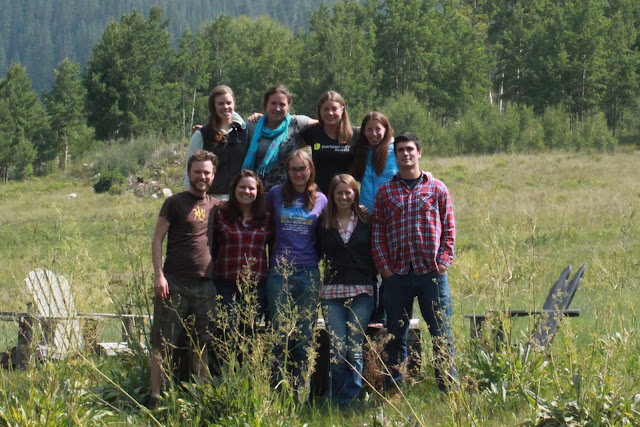Guest blog post from Riley Tippet, Owner Aspen Ski Butlers
"Power of Team" was the theme for Ski Butler's Annual Meetings this year, and in no place was this more evident than our time spent volunteering with the Aspen Center for Environmental Studies crew to install the winter bridges at Ashcroft.
It was the last day of our Meetings; an annual congregation of Ski Butlers to talk about the upcoming season, have fun and just be together. Every year we try to incorporate a half day of community involvement, in honor of Ski Butlers' Core Value #7: make a difference in the community. This is something we truly care about, and not only is it always an amazing experience, it's just plain fun.
A month or so prior to our meetings I contacted ACES' Community Outreach Director, Olivia, to see if they had a project we could help out with, and boy did they! Helping out a great organization, with awesome people, in one of the most gorgeous places in the valley, while exerting ourselves physically, equaled a great afternoon.
We met ACES staffers Adam and Howie and their crew in the Ashcroft ghost town parking lot, made our introductions, split into two groups and headed out to build our bridges. As we strolled through the old ghost town Howie gave us the run-down of Ashcroft's rise and fall. For better or worse, I'm sure the one fact every single person there can recall is that at one point Ashcroft had 14-20 saloons! This was hard to imagine as we walked around the few remaining buildings, but nonetheless this outlandish fact made everyone a bit thirsty. As we approached the river and saw the crossing we saw the three gigantic, let's call them "trees," that needed to be put in as the bridge base. By roping, pulling, dragging, lifting, grunting, and pushing we got all three in place, positioned the top planks and got our hammering on. You couldn't help but feel as if the "the bridge went out and they can't get the medicine to town" and we were the crew sent up the pass to reinstate the route. You know, "old timey" stuff; we were in a ghost town after all.
It was so great to jump into a large project with a group that had just met each other, move quickly and efficiently and, most of all, have fun doing it! Once we had completed the work we collected our tools, took the obligatory "We did it!" photos and headed back to the parking lot to meet up with the other group and see how their bridge came out. Thank you again ACES for showing us a great afternoon, getting us wet and dirty, and exemplifying the #PowerOfTeam.
So this winter, when you are snowshoeing up in Ashcroft, enjoying the splendor that is all around you and you come to a river crossing remember this: we deliver skis, we are not carpenters, cross at your own risk!
"Power of Team" was the theme for Ski Butler's Annual Meetings this year, and in no place was this more evident than our time spent volunteering with the Aspen Center for Environmental Studies crew to install the winter bridges at Ashcroft.
It was the last day of our Meetings; an annual congregation of Ski Butlers to talk about the upcoming season, have fun and just be together. Every year we try to incorporate a half day of community involvement, in honor of Ski Butlers' Core Value #7: make a difference in the community. This is something we truly care about, and not only is it always an amazing experience, it's just plain fun.
A month or so prior to our meetings I contacted ACES' Community Outreach Director, Olivia, to see if they had a project we could help out with, and boy did they! Helping out a great organization, with awesome people, in one of the most gorgeous places in the valley, while exerting ourselves physically, equaled a great afternoon.
We met ACES staffers Adam and Howie and their crew in the Ashcroft ghost town parking lot, made our introductions, split into two groups and headed out to build our bridges. As we strolled through the old ghost town Howie gave us the run-down of Ashcroft's rise and fall. For better or worse, I'm sure the one fact every single person there can recall is that at one point Ashcroft had 14-20 saloons! This was hard to imagine as we walked around the few remaining buildings, but nonetheless this outlandish fact made everyone a bit thirsty. As we approached the river and saw the crossing we saw the three gigantic, let's call them "trees," that needed to be put in as the bridge base. By roping, pulling, dragging, lifting, grunting, and pushing we got all three in place, positioned the top planks and got our hammering on. You couldn't help but feel as if the "the bridge went out and they can't get the medicine to town" and we were the crew sent up the pass to reinstate the route. You know, "old timey" stuff; we were in a ghost town after all.
It was so great to jump into a large project with a group that had just met each other, move quickly and efficiently and, most of all, have fun doing it! Once we had completed the work we collected our tools, took the obligatory "We did it!" photos and headed back to the parking lot to meet up with the other group and see how their bridge came out. Thank you again ACES for showing us a great afternoon, getting us wet and dirty, and exemplifying the #PowerOfTeam.
So this winter, when you are snowshoeing up in Ashcroft, enjoying the splendor that is all around you and you come to a river crossing remember this: we deliver skis, we are not carpenters, cross at your own risk!























.JPG)